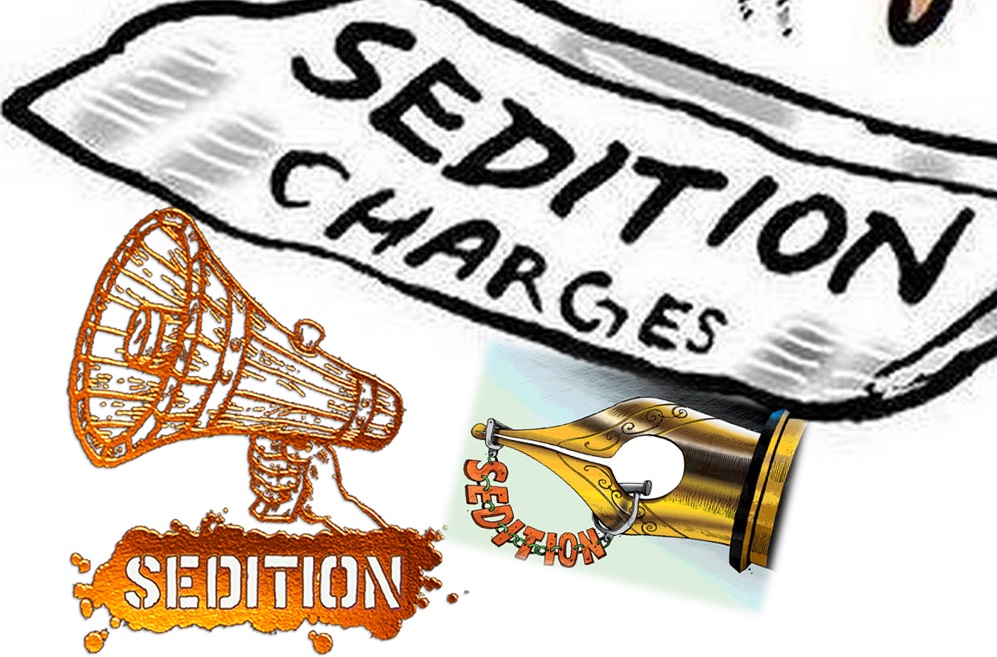AnalyticsBreaking News
Assam tops list in Sedition Cases

Dec. 5: Under the sedition law, Assam reported the greatest number of cases (66), followed by Jharkhand (40), Karnataka (38), and Haryana (37) during the seven-year period of 2014 to 2020. These four states, along with Jammu & Kashmir, Bihar, Kerala, Uttar Pradesh, and Manipur accounted for 76% of the 399 cases registered under Sedition in all of India between 2014 and 2020. On the other side, Maharashtra and Punjab reported only one case each under sedition during this period.
 According to data revealed by the Home Ministry, out of 66 cases from Assam, 12 cases were filed during the year 2020, 17 cases were filed in the year 2019, 17 cases were filed in the year 2018, 19 cases were filed in the year 2017 and only 1 case filed in the year 2014. It is also revealed that 54 cases under Section 124A of IPC were filed in the year 2014 to 2019 and out of said 54 cases from Assam, charge sheets were filed in 26 cases and 25 trials were completed without a single conviction.
According to data revealed by the Home Ministry, out of 66 cases from Assam, 12 cases were filed during the year 2020, 17 cases were filed in the year 2019, 17 cases were filed in the year 2018, 19 cases were filed in the year 2017 and only 1 case filed in the year 2014. It is also revealed that 54 cases under Section 124A of IPC were filed in the year 2014 to 2019 and out of said 54 cases from Assam, charge sheets were filed in 26 cases and 25 trials were completed without a single conviction.
 What exactly is Sedition?
What exactly is Sedition?
As per Dictionary.com, Sedition is, “incitement of discontent or rebellion against a government by any action especially in speech or writing.” According to A.T. Dev Students’ Favourite Dictionary, Sedition means “the stirring up of discontent or rebellious feeling against the authority of a State or Monarch”.
Section 124A of Indan Penal Code defines Sedition more elaborately, “Whoever, by words, either spoken or written, or by signs, or by visible representation, or otherwise, brings or attempts to bring into hatred or contempt, or excites or attempts to excite disaffection towards the government established by law in India.”
 Further, Sedition is a non-bailable offence. Punishment under the law varies from imprisonment up to three years to a life term and fine. A person charged under this law can’t apply for a government job. They have to live without their passport and must present themselves in the court as and when required.
Further, Sedition is a non-bailable offence. Punishment under the law varies from imprisonment up to three years to a life term and fine. A person charged under this law can’t apply for a government job. They have to live without their passport and must present themselves in the court as and when required.
Incidentally, Section 124A has had an interesting history. Initially, it was a part of the Section 113 introduced by the British historian Thomas Macaulay in 1837. But for unknown reasons, it was then omitted from the actual Code in 1860; however, it was eventually added to the Code in 1870 at the suggestion of James Stephen, a British judge and writer. Later, the Stephen’s version was also substantially changed via IPC Amendment Act of 1898; the present Act is very much similar to that Section.
 Bal Gangadhar Tilak was the first person to be convicted of sedition in colonial India. The British government brought the charge alleging articles carried in Tilak’s Marathi newspaper Kesari would encourage people to foil the government’s efforts at curbing the plague epidemic in India. In 1897, Tilak was punished by the Bombay high court for sedition under Section 124A and was sentenced to 18 months in prison.
Bal Gangadhar Tilak was the first person to be convicted of sedition in colonial India. The British government brought the charge alleging articles carried in Tilak’s Marathi newspaper Kesari would encourage people to foil the government’s efforts at curbing the plague epidemic in India. In 1897, Tilak was punished by the Bombay high court for sedition under Section 124A and was sentenced to 18 months in prison.
 After Independence, “sedition” was dropped from the Constitution in 1948 after discussions of the Constituent Assembly. KM Munshi moved an amendment to remove the word “sedition” that was included in the draft Constitution as a ground to impose restrictions on constitutional freedom of speech and expression. The word “sedition” thus disappeared from the Constitution when it was adopted on November 26, 1949 and Article 19(1)(a) of the Constitution guarantees Indian citizens’ freedom of speech and expression.
After Independence, “sedition” was dropped from the Constitution in 1948 after discussions of the Constituent Assembly. KM Munshi moved an amendment to remove the word “sedition” that was included in the draft Constitution as a ground to impose restrictions on constitutional freedom of speech and expression. The word “sedition” thus disappeared from the Constitution when it was adopted on November 26, 1949 and Article 19(1)(a) of the Constitution guarantees Indian citizens’ freedom of speech and expression.
Jawaharlal Nehru introduced the First Amendment to the Constitution in 1951, which limited freedom under Article 19(1)(a) and enacted Article 19(2) thus empowering the state to impose “reasonable restrictions” on the right to free speech.
 For the first time in India’s history, the Indira Gandhi government declared Section 124A a cognizable offence in the Code of Criminal Procedure, 1973, which came into effect in 1974 and replaced the colonial-era 1898 Code of Criminal Procedure, allowing the police to conduct arrests without a warrant.
For the first time in India’s history, the Indira Gandhi government declared Section 124A a cognizable offence in the Code of Criminal Procedure, 1973, which came into effect in 1974 and replaced the colonial-era 1898 Code of Criminal Procedure, allowing the police to conduct arrests without a warrant.



